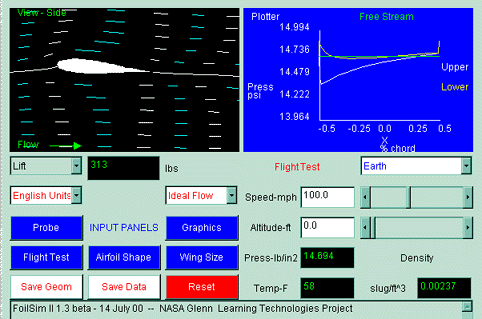
|
Using 3-D Models for Code
Validation with FoilSim
|

|
Subject Area: Industrial Technology and Mathematics
Grade Level: 9 - 12
National Standards:
Mathematics
- Use and value the connections between mathematics and other
disciplines.
- Construct and draw inferences from charts, tables, and
graphs that summarize data from real-world situations.
Technology
- Technology Research Tools - Select and apply
technology tools for research, information analysis,
problem-solving, and decision-making in content learning.
- Technology Problem-Solving and Decision-Making Tools
- Routinely and efficiently use on-line information resources
to meet needs for collaboration, research, publications,
communications, and productivity.
Objective:
After reading the explanation given below and an
explanation of lift and wing area from a NASA Web site, use
FoilSim to complete the activity to create tables of data sets
comparing the lift values for a 3-D model of a symmetrical wing
section to the values predicted by the FoilSim software.
Beginner's
Guide to Aerodynamics is a "textbook" of information prepared at
NASA Glenn Research Center to help you better understand how
airplanes work. Click Beginner's
Guide Index to access the list of slides. Open the slide called
Size Effect (with text)
and read the explanation on how lift is directly proportional to the
wing area.
FoilSim is an interactive
simulation software package that examines the airflow around various shapes
of airfoils. As you change parameters such as airspeed, altitude, angle
of attack, thickness and curvature of the airfoil, and size of the wing
area, the software calculates the lift. The package was created at the NASA
Glenn Research Center.
FoilSim II is a Java applet program that executes inside the browser of your computer.
It is available on the World Wide Web at
http://www.grc.nasa.gov/WWW/K-12/airplane/foil2.html.
You can also
download the program to run off-line.
Shown below is a screen
shot from the program's controls and displays. You may change the values
of the variables by using the slider or the input box on the left of the
slider.
To use the slider:
- Click the mouse
pointer on the arrows at the ends of the slider.
- Click the mouse
pointer anywhere between the slider and the arrow.
- Drag the slider
with the mouse.
To use the input
box:
Simply select the
value in the input box, key in the new value, and press Enter or Tab when
finished. The button on the slider will move corresponding to the value
typed in the box.

Using the FoilSim program, complete the 3-D
Models for Code Validation Activity.
Assessment:
You, or you and your partner(s), will be evaluated on the
feasibility or accuracy of your answers.
Evaluation:
You will demonstrate the ability to use information found
on the World Wide Web to complete the activity to create tables of
data sets comparing the lift values for a 3-D model of a
symmetrical wing section to the values predicted by FoilSim.
Submitted by:
William Glynn, Brookside High School, Sheffield, Ohio
E-mail: billg@centuryinter.net
|
